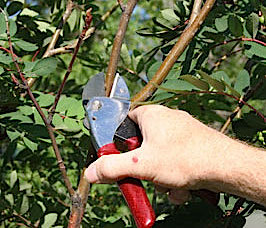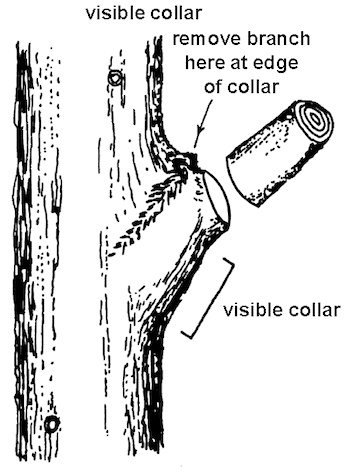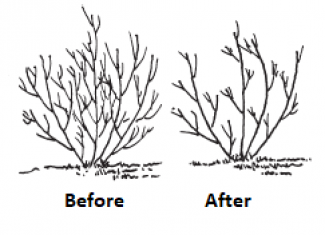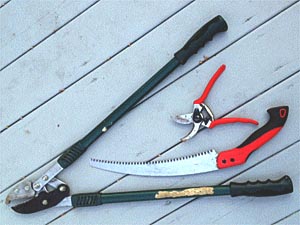To Prune or Not to Prune? That is the Question
By Carolyn R. Casey, Fairfax Master Gardener Intern
 For some people, the idea of pruning can be intimidating. But it does not have to be. Pruning is not difficult if you understand the basics. To prune successfully you need to be aware of why you should prune, when to prune and how to prune. Correct pruning is essential for keeping trees and shrubs healthy. It can help you manage the size of your trees and shrubs. Every year, you should examine the trees and shrubs in your yard to decide whether they need to be pruned. Once you decide, you should only prune one-third of the plant each year until you achieve the desired shape. This is called the “one-third rule,” and it provides a basic guide to pruning established and mature trees and shrubs.
For some people, the idea of pruning can be intimidating. But it does not have to be. Pruning is not difficult if you understand the basics. To prune successfully you need to be aware of why you should prune, when to prune and how to prune. Correct pruning is essential for keeping trees and shrubs healthy. It can help you manage the size of your trees and shrubs. Every year, you should examine the trees and shrubs in your yard to decide whether they need to be pruned. Once you decide, you should only prune one-third of the plant each year until you achieve the desired shape. This is called the “one-third rule,” and it provides a basic guide to pruning established and mature trees and shrubs.
It is important to note that pruning is typically done in stages. Step back from the plant that you want to prune and examine it. Where does it need to be pruned? After each cut you will want to step back and look at your plant again. Are you achieving the desired shape?
Pruning Strategies
It is important to prune all dead, diseased and damaged branches as soon as possible after you notice them. Prune out downward growing branches. When you have two branches that cross each other, keep the dominant branch or the one that is going in the best direction for future growth. Prune out any branches that are larger in diameter than the trunk. Typically, you want to remove them before they become this large. Otherwise, you may create a large wound from pruning that does not seal completely. Remove suckers that are coming up from the roots. Also, prune out the small vertical branches called water sprouts that grow from a pruning wound, crack or other damage to the tree.

Pruning at collar
Newly planted trees and shrubs need as many healthy leaves as possible for photosynthesis and food production for use in establishing roots. For the first growing season, prune out only the dead, diseased or damaged branches. This helps young plants to develop strong structures. Do not cut back the main leader of a tree or shrub. Pruning out the lower branches in young trees over time will raise the crown.
It is better to prune branches when they are small. There will be less chance of disease and the area will heal faster. When plants are not pruned properly or not pruned at all for several years, they may later need heavy pruning to remove large branches.
Pruning Timing
When you decide to prune your trees and shrubs, you need to consider the plants’ flowering, fruiting and growth habits. If you prune at the wrong time of year, you will lose the next year’s flowers. Also, pruning at the wrong time of year can cause wounds to trees and shrubs that make them susceptible to disease, and any new growth may be killed by frost. The rule of thumb for trees and shrubs that flower before the end of June (spring-flowering) is to prune them right after their blooms have finished. Examples of these plants are forsythia, azalea, Virginia sweetspire, mock orange, ninebark, quince and rhododendron. Summer flowering plants bloom after the end of June. These trees and shrubs need to be pruned in the winter or early spring before the new growth starts. Examples of these plants are butterfly bush, crape myrtle, holly and nandina. In the summer, do not prune during hot and dry weather. After a drought, wait for the next growing season so you can see what has died. This keeps you from pruning out live branches.
Pruning broad-leaved plants, evergreens and conifers can be done when the wood is not frozen. When pruning conifers such as pines, spruces or firs, avoid cutting beyond the living foliage on branches, since they usually will not form new growth on older wood. Tightly pruned conifers are prone to stress, disease and insect damage. Pinching half of the new growth that looks like “candles” when they are about 2 inches long thickens the new growth. Do not use shears to prune conifers. This damages the needles near the candles and causes the cut edges to turn brown. Also, never top or prune out the central leader of a conifer tree.
If you are growing plants for their fruit, they should be pruned after their fruit drops. Always allow this year’s fruit to develop on trees and shrubs. Examples of these types of plants are viburnum and hawthorn. Pruning to keep certain trees from bleeding sap should be done in midsummer or late fall. Examples of these plants are maple, birch, dogwood, elm, walnut and yellowwood. Pruning plants that bleed may stimulate new growth.
How To Prune
There are several different reasons for pruning. Deadheading is used for removal of spent flowers from your trees and shrubs. It makes your plants look tidier and promotes bloom formation and can prevent seed and fruit formation. Heading is for removing a portion of a stem usually at the internodal point. This is a cut between two buds or nodes. This type of pruning is used to create and maintain hedges and topiaries. Rejuvenation pruning removes the oldest branches, cutting them to the ground. This can be done in stages or all at once.
Topping your trees is called “rounding or heading” and is a form of poor pruning that can ruin the tree’s shape and health with excessive canopy removal and poor cuts. Topping is the indiscriminate removal of branches between internodes and not where branches meet, leaving stubs and wounds which cannot heal properly. This provides the opportunity for disease and decay. Instead of topping your tree, prune out the branches by making cuts so that you are removing the branch in small sections. This helps the tree maintain its natural shape. Note: pruning cuts should always be made one-fourth inch above an active bud. This keeps the stems from dying back and allows for new branch formation.

Pruning by thinning cuts
Thinning cuts eliminate a branch back to the trunk or a primary stem just outside the branch collar or branch bark ridge. The branch bark ridge is a raised strip of bark at the top of the branch union where the growth and expansion of the trunk or parent stem and adjoining branch push the bark into a ridge structure. This is typically present on every branch union and is an important identifying feature for determining pruning tool placement. The branch bark ridge is used to determine where to cut if the branch collar is not visible.
When removing a limb larger than 2 inches in diameter, a three-cut method is used. The first cut, an undercut, prevents bark from ripping potentially down into the branch collar. This cut should be between 4 and 6 inches from the collar, depending on the diameter of the branch. The second cut, a top cut, removes the branch’s weight. The third cut removes the stub left at the collar and will determine how quickly and well the plant closes the wound. This is the most important cut. Its success is based on the placement (proximity to branch collar), the angle (which determines both the size and shape of the wound) and the proficiency (whether the wound is smooth and clean). When cutting a limb of this size, use a clean, sharp, hand saw to make the cleanest possible cut.

Pruning Tools and Rules of Safety
Here are some basic rules of safety to be aware of when pruning. For large trees, call a certified arborist. All tools should be kept sharp and clean. Tools should only be used for the job that they are intended to do. Always be aware of power lines. You will need to call the power company if there is a branch near or touching a power line that needs to be pruned. Also, stay away from the branch. Never climb a tree without a safety rope (with and without a ladder). Wear gloves and eye protection when pruning trees and shrubs. Never paint or use pruning seal on the branches of trees and shrubs you have pruned.
There are several different types of tools that are helpful when you are pruning trees and shrubs. Use hand pruners to prune branches that are one-fourth to one-half inch in diameter. When choosing hand pruners, I find that the bypass pruners are a better choice. Anvil pruners may crush the branch and damage it instead of making a nice clean cut. When pruning branches that are 1 1/2 inches in diameter, use lopping shears. These are available as bypass and anvil pruners. I prefer the bypass pruners for the same reason I like the bypass hand pruners. Pruning saws are used for cutting branches 1 inch or more in diameter. A combination pole saw and pole pruner is useful for pruning branches that you cannot reach. Hedge shears are used to prune new growth, and they can be either power or hand operated tools. A chainsaw can be useful for cutting branches that are already on the ground.
Clean your pruning tools with soap and water and a stiff bristle brush after each use. Then disinfect them with products containing 0.1 percent alkyl dimethyl benzyl ammonium saccharinate, such as Lysol All Purpose Cleaner. This will kill bacteria, viruses and fungi. Always read the label and use at full strength. You can also use isopropyl alcohol with 70 percent or higher concentration to disinfect small hand pruners and tools. Bleach is not recommended for disinfecting pruning tools, since it can corrode metal and dull cutting blades.
Thank you to David Yost from Merrifield Garden Center for his assistance with this article.
Resources
• Proper Pruning Principles, Der Holcomb, Alexander County Center, North Carolina State University
Extension
• How to Prune Specific Plants, Barbara Fair, Department of Horticultural Science, North Carolina State
University Extension
• Pruning Ornamental Trees and Shrubs, Rosie Lerner and Kyle Daniel, Department of Horticulture and
Landscape Architecture, Lindsey Purcell, Department of Forestry and Natural Resources, Purdue
University Extension
• Pruning Trees and Shrubs, University of Minnesota Extension
• General Pruning Techniques, Barbara Fair, North Carolina State University Extension
• Clean and Disinfect Gardening Tools and Containers, Julie Weisenhorn, Natalie Hoidal, and Annalisa
Hultberg, University of Minnesota Extension